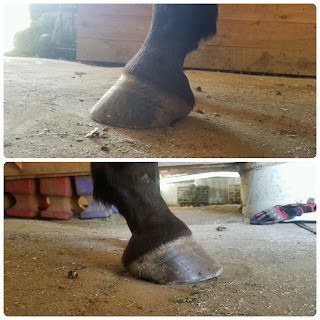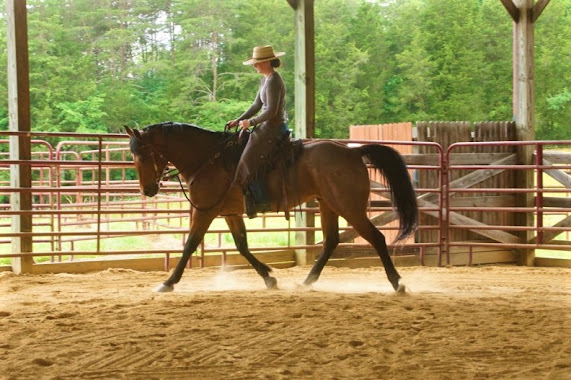The importance of subtleties
As horse owners, most of us outsource a lot of our horses' care. We have farriers who trim and shoe, boarding barns that feed, bed and keep an eye on our horses, and vets that help us diagnose maladies and ward off larger issues. We have saddle fitters, coaches and trainers, feed reps and nutritionists and countless styles and types of bodyworkers and therapists.
And of course, we have other horse people, most of whom are often too happy to offer up an opinion or two.
Point being, we've got more experts and resources at our fingertips than ever before in the history of horse husbandry. Don't get me wrong, it's wonderful to have so much access to so much information...but it does come with a few unfortunate side effects, the biggest (in my humble opinion) being that many a horse person has very little understanding around basics aspects of their horse's needs and thus cannot spot a snake oil salesman or armchair expert. When you don't know what you don't know, it's hard to make informed decisions, and relying on others to have all the answers can be a dangerous game to play.
This is not at ALL to say that relying on the knowledge of others is a bad thing, or makes one a bad owner. We all have to learn somehow and oftentimes that is through either A) making mistakes, or B) finding really good, trusted mentors that can help guide you because they care about you and your horse, not some bottom line. All of us have learned via hoeing A's tough row. The few among us who get lucky find B.
I have been extremely fortunate to find several good mentors in varying aspects of horsemanship and horse keeping throughout the years, among them being an excellent horsewoman named Barb Gerbitz. Prior to going out to Illinois back in 2018 to apprentice with Barb, I had learned how to trim hooves and knew a good sum about hoof care and trimming but hadn't worked up the courage to take care of my own herd. Barb changed that, as she had me under a horse almost daily in addition to working with colts. I came back to Vermont feeling much more confident about my trimming skills and have taken care of Soni and the donkeys' feet ever since.
Soni's feet post-trim back in August. Top is RF, bottom is LF. You can see the difference immediately between the two feet: his left is more textbook - he has good angle with ample heel bulb and his growth outward from the coronary band is *almost* ideal in that it closely matches the angle of his pastern and hoof wall. His right side doesn't have quite the heel development of the left and you can see the growth is more heavily slanted forward, giving him a propensity to grow more toe. I am always looking to back that right toe up as much as I can to encourage his foot growth to look more like the left.Being my own farrier has given me access to invaluable information I might never have known had I not been monitoring my herd's hoof health. In Soni's case, it has also allowed me to watch his feet improve over time as his posture under saddle gets better and better and help him along in those changes by not allowing his hooves to get out of balance. I also get information about my herd's diet: in Pico's case, poor nutrition early in life left him very prone to metabolic issues, which will show up in his feet if I'm not careful. He's always got a bit of a hard crest, but so long as his feet stay in good shape I know he's managing okay.
Even Soni - my hard keeping QH who lives on 2nd cut hay and alfalfa pellets (read: a pretty rich diet) - isn't immune to foot issues. He he excellent feet overall: big, good concavity, consistent growth of quality hoof horn and lots of sole. For the last couple of years his feet have been steadily improving as he's gotten straighter in his way of going and I've had to do less and less correction each trim. This past spring I decided to try him shod up front to give him a bit more support with the intent of pulling his shoes for the winter. He went wonderfully all through summer and into fall, so much so that I decided to try him shod through the winter. That lasted all of two weeks: the abnormally warm temps made for soul-sucking mud, and the high clay soils at the barn Soni lives at took his LF clean off two weeks after my farrier had tacked them on.
I took the hint and pulled the other shoe. This is what I found:
Very few of us test our hay - we judge a good bale from a bad bale by much more superficial means and often assume that a later cut is richer and higher in sugars than an earlier cut. However, the environmental stressors in play during the growing season have a huge effect on the level of sugar in forages. In this case, Vermont had experienced a very dry summer and exceptionally dry fall; it had also stayed, on average, much warmer for much longer than it normally does heading into winter. Drought conditions cause plants slow growth and more importantly store NSC (non-structural carbohydrates) as a survival mechanism. There had been whispers all summer of a hay shortage as the lack of rain meant lack of growth, so the first cut was delayed and many growers were lucky to get in a second. Thus, much of the first cut hay grown in the area - the very first cut hay that Soni was being fed - likely has an abnormally high NSC value. Horses aren't adept to deal with high levels of sugar in their feed and the inflammation it causes often affects the sensitive live tissues in the hoof.
Because Soni is boarded, I don't have the ability to test the hay. I don't have control over where it comes from and each delivery, while from the same supplier, could be from a completely different field, a different farm or even an entirely different part of the state. I could ask his hay be soaked to try and remove the excess sugars, but soaking hay AND feeding it to a horse that lives out 24/7 AND doing so in winter is not easy and a tall order for a lot of facilities unless it's absolutely necessary.
So I'll monitor his feet closely. I'll touch him up every couple of weeks and watch his white lines for any additional changes. My gut tells me removing the mechanical stressors on his toes and getting him into better balance will go a long way in tightening up his white line. In a perfect world I'd probably be soaking his hay, too - however not being able to wholly address the subtleties doesn't negate the benefit of noticing them in the first place. You can't address what you don't know, but if you don't know what you don't know you're almost certain to make a lot more mistakes in trying to address it.





Comments
Post a Comment